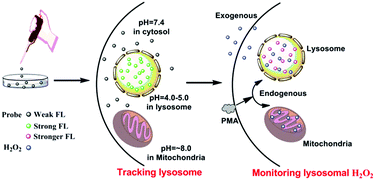A selenamorpholine-based redox-responsive fluorescent probe for targeting lysosome and visualizing exogenous/endogenous hydrogen peroxide in living cells and zebrafish†
Abstract
A simple selenamorpholine-based fluorescent probe has been designed and synthesized using a combination of selenamorpholine and a BODIPY fluorophore. BODIPY–Se has a low pKa value of 4.78 because of the selenamorpholine unit, which is beneficial for the probe to detect the lysosome. BODIPY–Se can turn on partial fluorescence only in lysosomes, due to a PET-inhibited process of protonation of selenamorpholine. In addition, the selenamorpholine unit of BODIPY–Se could selectively react with H2O2 through a redox reaction, leading to the alteration of the valence state of selenium from Se(II) to Se(IV) and an additional PET-inhibited process. When BODIPY–Se tracked H2O2 in lysosomes, the two PET-inhibited processes would obviously amplify the fluorescence signal in living cells and in vivo. The probe could also detect the redox cycles between H2O2 and GSH continuously. Using confocal fluorescence imaging, the fluorescence localization of lysosomes demonstrated that BODIPY–Se could successfully target lysosomes. The probe could not only detect exogenous/endogenous H2O2 in living cells, but could also realize real-time monitoring of H2O2 in cancer cells and zebrafish. The results proved that BODIPY–Se is a promising fluorescent probe in biological applications.



 Please wait while we load your content...
Please wait while we load your content...